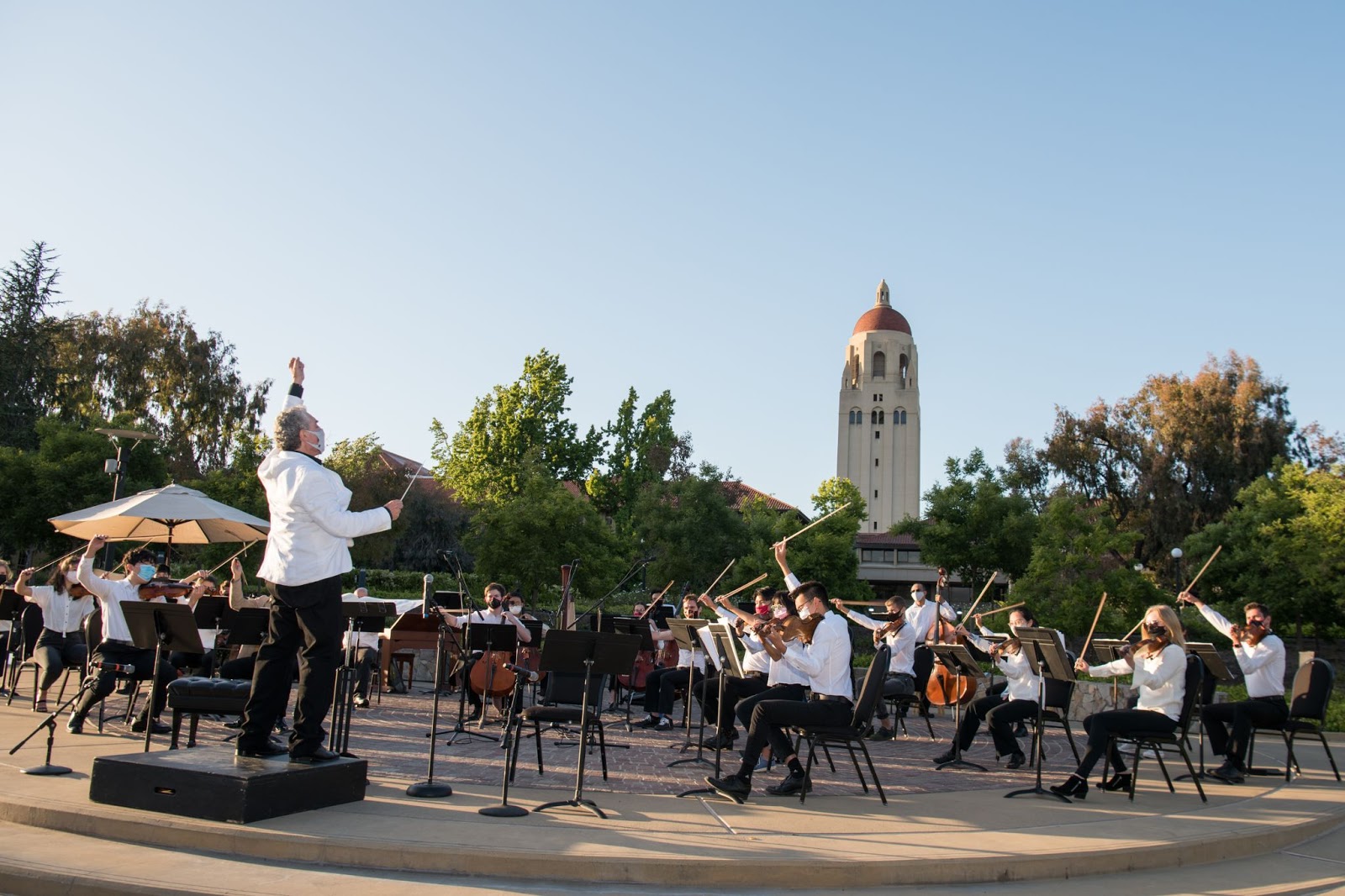In March 2020, the Stanford Philharmonia (SP) played what would become its final concert of the 2019-20 season. With that performance, Stanford’s orchestras ventured into an indefinite hiatus from live, in-person music. Last Wednesday, over 14 months later, SP provided the second bookend to this interregnum with a free outdoor concert on Meyer Green.
Evidently, the past year’s lack of live orchestral music did not go unnoticed in the community. Hundreds of students and faculty flooded Meyer lawn, quickly outnumbering the two dozen or so chairs set up for the event. On makeshift windbreaker blankets, many with dinner in hand, audience members sat and listened to an hour and a half of gorgeous orchestral works that ranged from the Baroque period to the 20th century. Though the performance was not without some technical mishaps — wind and sheet music were natural enemies — its emotional potency was clearly communicated, and its importance for Stanford’s music department cannot be overstated.
SP’s rehearsal process, as orchestra director Paul Phillips attests, was no cakewalk. “String players are used to sitting together, two musicians per stand. Sitting apart, one per stand, felt strange at first. The physical distance between the musicians made it much harder to play together, and it took a couple of weeks playing like that before we got used to it and began to play together in a more comfortable, natural way,” he said.
The concert featured works from Florence Price and William Grant Still, two Black composers that Phillips noted as “being rediscovered” in the wake of last summer’s Black Lives Matter Protests. The program also included Elgar’s “Sospiri,” Dvorak’s Serenade for Strings and the Vivaldi Concerto for Two Cellos, performed by faculty soloists Christopher Costanza and Stephen Harrison. Phillips also took the event as an opportunity to honor the orchestra’s graduating seniors (all class of 2021): Tony Kim, Carling Hank, Hannah Mueller, Andre Turati, Martin Altenburg, Carson Conley, Erik Roise, Grace Mueller, Bryant Huang, Meilinda Sun and Daphne Guo.
The choice of Meyer Green as a performance location resulted in some technical difficulties. Cello soloist Stephen Harrison recalled the unpredictability of playing outdoors: “The one rehearsal we had outside, it was 89 degrees … so they moved the concert to 6 p.m., little knowing the wind would be worse!”
The soloists and many audience members noted the high frequency of unwanted interruptions at the outdoor venue. In addition to the wind and some faulty microphones, the clock tower rang five times during SP’s performance. But Costanza felt very fortunate to be able to perform again: “It’s awfully exciting to have a live audience out there to look at and play for. You feel energy coming from them, you feel engagement; you can’t get that from playing for a video camera!” Some students, like Amanda Koong ’21, even enjoyed the location. “The concert was super fun — I love this venue! I think that they should continue to do it here,” she said.
For many, this concert was their first experience listening to Stanford Orchestras. Graduate student Matthew Henderson had “attending a live performance” on his to-do list of on-campus experiences: “This is the first event I’ve been able to actually come to in-person, which is why I was so excited. So many things have been shut down. And I’m not the only one — it seems like there’s a ton of people who want to go to events like this, and now’s the time when we can finally attend them.”
Elóra Henderson J.D. ’23 expressed a similar sentiment: “I’m elated; I’m over the moon. It’s one thing to have the concert, but it’s also really great to see everyone who came. I honestly wasn’t expecting a lot of people to be here, just because I haven’t seen so many people in one space [in so long].” Geophysics PhD student Julio Frigerio, who attended with his partner and children, marked the concert as a “new horizon.” “It was a special moment, and it’s going be in our memories forever,” Frigerio said.
The future seems bright for the Stanford Orchestras, Phillips said. “Performing this concert has given everyone who was there — either as a performer or audience member — the feeling that we’re getting through the pandemic and getting much closer to returning to normal life. I’m hoping that Stanford Philharmonia and the Stanford Symphony Orchestra will be able to return to normal this fall, with woodwinds, brass and percussion able to play once again with us.” The concert brought with it hope, humor and one of the clearest signs yet that Stanford campus will soon be full of life again.
In an earlier version of this article, the list of graduating seniors included Kevin Jung and excluded Meilinda Sun and Daphne Guo. The Daily regrets this error.
